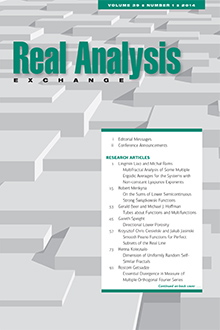Abstract
A function $g$ between directed sets $\langle \Sigma, \succeq' \rangle$ and $\langle \Lambda, \succeq \rangle$ is called \emph{ultimately increasing} if for each $\sigma_1 \in \Sigma$ there exists $\sigma_2 \succeq' \sigma_1$ such that $\sigma \succeq' \sigma_2 \Rightarrow g(\sigma)\succeq g(\sigma_1)$. A subnet of a net $a$ defined on $\langle \Lambda, \succeq \rangle$ \cite {Ke} is nothing but a composition of the form $a \circ g$ where $g$ is ultimately increasing and $g(\Sigma)$ is a cofinal subset of $\Lambda$. While even for linearly ordered sets, an increasing net defined on a cofinal subset of the domain need not have an increasing extension, in complete generality, it must have an ultimately increasing extension, and conversely when the domain is linearly ordered. Applications are given in the context of functions with values in a linearly ordered set equipped with the order topology - in particular, the extended real numbers. For example, we show that a real sequence $\langle a_n \rangle$ converges to the supremum of its set of terms if and only if $\langle a_n \rangle$ is the supremum of the ultimately increasing sequences that it majorizes.
Citation
Gerald Beer. Jesús Rodríguez-López. "Ultimately Increasing Functions." Real Anal. Exchange 36 (1) 195 - 212, 2010/2011.
Information





